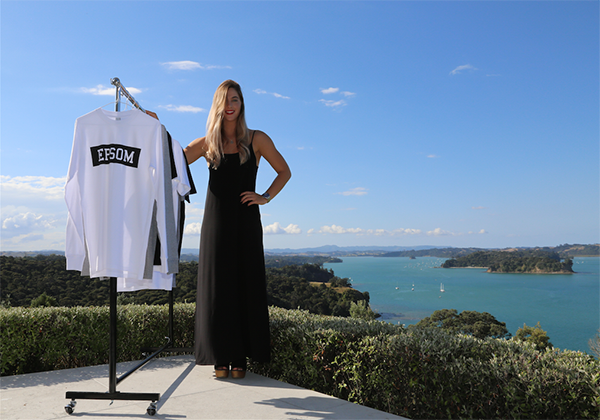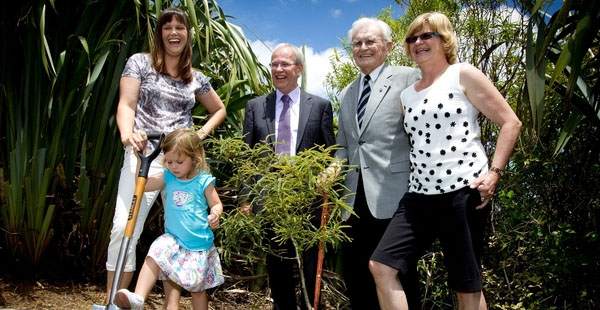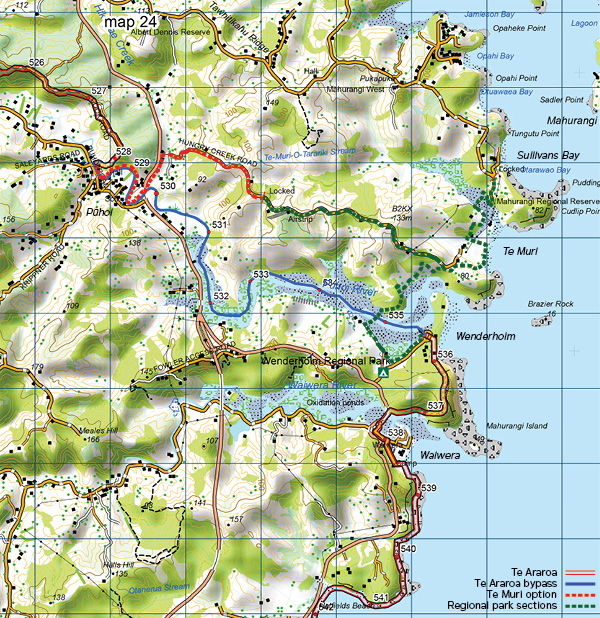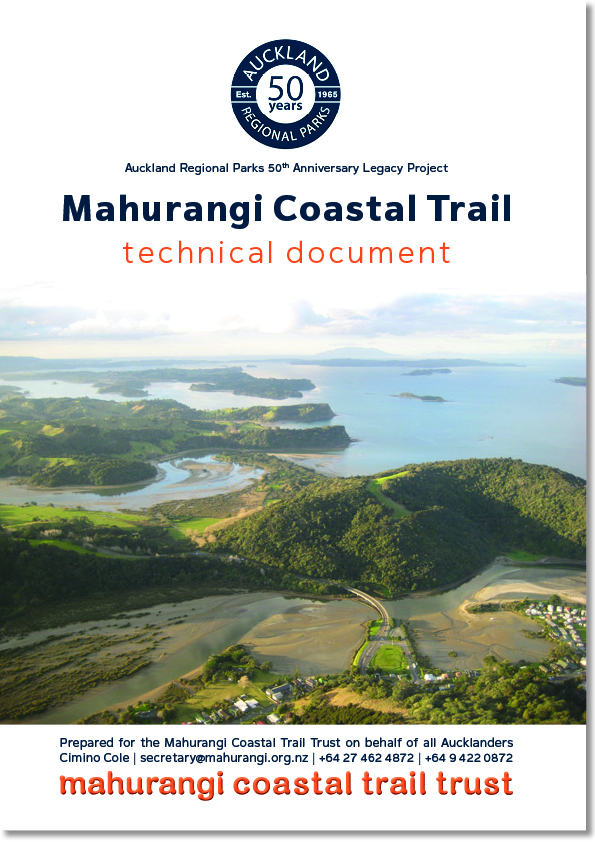Mahurangi Coastal Trail celebrity fundraiser

Taking Vantage: No venue has a more breathtaking vantage of the coastline to be traversed by the Mahurangi Coastal Trail than Tu Ngutu Villa, immediately overlooking Mita and Sullivans bays, in the Mahurangi Regional Park, but also boasting views, to the south, of Te Muri Bluff and Maungatauhoro, the Wenderholm bluff. Pictured is Mahurangi Action vice-president Tessa Berger, at the Valentine’s Day launch of her start-up, Lane Merchandise. photographer Maree Owston-Doyle
The Auckland Regional Parks 50th anniversary, legacy project.
That is what the Mahurangi Coastal Trail must become, if Aucklanders are to mark the first fifty years of their incomparable network of regional parks in a manner befitting its scale and vision.
And in particular, when the main celebration is held at Wenderholm, where it all began, the surviving of the two men who made the regional parks possible, must be honoured by his name being immortalised at what will become the southern abutment of the ‘Judge Arnold Turner Footbridge’, to cross the Pūhoi River, on the Sunday of Auckland Anniversary weekend, 2016.
Come the 31st of next month, Wenderholm Regional Park will have been purchased precisely 50 years ago. Some might argue that that date, a Tuesday, should mark the main celebration of the regional parks network. But in March of 1965 Aucklanders were only very dimly aware of what was being created for them, by dint of the vision and perseverance of Frederick W O Jones, Auckland’s first regional planner, and to the support he received from Judge Arnold R Turner, particularly the drafting of the legislation that enabled Wenderholm, and a further 27 regional parks since, to be purchased.
What happened immediately after 31 March 1965 is instructive, in respect to the timing of the 50th anniversary celebration. In the piece he wrote thirteen years ago, for Mahurangi Action, Judge Arnold Turner, since, Judge Arnold Turner CMG, says:
Once the land had been purchased, regional authority staff were then inclined to relax as if nothing further was necessary—the land had been protected! But I insisted that the park be made ready and opened for public use by the summer of 1965. I said that Aucklanders were very interested in the acquisition and were entitled to see what their money had been spent on.
Judge Arnold Turner prevailed, nevertheless it wasn’t until the following summer that Wenderholm was opened to its soon-to-be-besotted public. The enthusiasm that the park enjoyed was immediate, as was the impact on patronage at the hot mineral pools at adjacent Waiwera, where the little town had been reaching saturation point on holiday weekends, regardless of how sunny the weather, or inviting the beach, less than 200 metres distant—in the mid-1960s, Waiwera–Wenderholm was the northern limit for most day-tripping Aucklanders.

Marking 50-Year History: On the 50th anniversary of the passing of the legislation that established the Auckland Regional Authority, a ceremony was held with similar actors as one performed near that time, which featured Judge Arnold Turner’s eldest daughter, right, at an comparable age to her granddaughter here. Justice Turner drafted the clauses in the 1963 legislation establishing the authority that empowered it to purchase the regional parks, beginning with Wenderholm. photographer Sarah Ivey
Wenderholm, in any event, is inescapable as the venue, which is why the Mahurangi Coastal Trail, linking Mahurangi Regional Park with the two adjoining parks to the north, Te Muri and Mahurangi, is the perfect 50th anniversary, legacy project. The coastal trail is also profoundly important for three quite separate, but complementary reasons: Firstly, the potential of the whole of the three contiguous Mahurangi regional parks is far greater than the sum of the individual parks. Wilderness camping at Te Muri, for example, will be an even richer experience, with the ability of campers to roam 18 kilometres to the Waiwera River, thence to Ōpahi, in the Mahurangi, and back, without leaving the park. A future, inevitable, Mahurangi Harbour ferry will extend this range to the regional parkland at the end of the Scotts Landing and Mahurangi peninsulas.
Secondly, the Mahurangi Coastal Trail is the low-hanging fruit, in respect to public transport access to the region’s regional park network. As magnificent as it is, Auckland Regional Parks reflect the car-centric thinking prevalent at their inception. But with Waiwera being the northern terminus of the metropolitan transport system, the Mahurangi Coastal Trail provides low-greenhouse-gas-emission access to all Aucklanders, but particularly the increasing number of young people who see individual vehicle ownership as a mug’s game, and, collectively, an egregiously climate-damaging one to boot. The better use of buses, as so convincingly demonstrated by the Northern Busway, is a no-brainer and should be the city’s, and any non-rail-fanatical mayor’s, top transport priority.
Finally, and most importantly to those who see Te Araroa, one day, defining Aotearoa, the coastal trail provides the best and most magnificent connection to New Zealand’s national walkway. Te Araroa Trust is aware of the proposal and watches on with interest. Once Auckland Council’s position is established, the trust will further consider the merits of Te Muri becoming a part of the national walkway.

Gateway to the North: The purchase of the 407-hectare Schischka farm at Te Muri was intended to take pressure off Wenderholm, but it can do that and more, if, instead of creating yet another, $3 million, road, it forms a sublime interface between the magnificent Auckland Regional Parks network, and what deserves to become synonymous with Aotearoa and tourism—Te Araroa. map Te Araroa Trust proposed te muri route and legend Mahurangi Magazine
Spearheaded by a then extant and dynamic residents and ratepayers association, Mahurangi West residents headed off a 1980s parks proposal to develop Te Muri for vehicle access, which involved a two-lane road and concrete road bridge across the much-cherished estuary, and parking for 4000 cars. The association argued that Te Muri could be better developed for walking access only, while preserving the splendid sense of isolation the place afforded—wholly because, rather than drive directly to it, the 10-minute walk facilitated a mental change of gear; a gently coerced meditation. Users of the beach were provided with an unexpectedly tranquil experience, contrasting refreshingly with the densely used, vehicle accessed, beaches immediately to the north, at Sullivans Bay, but particularly to the south, at a thronging Wenderholm. Typically, such submissions fall on cloth council ears, but, in those enlightened times, the park management plan process involved a citizens advisory group that reported on submissions before staff prepared the council’s draft response. Crucially, the group was chaired by Justice Turner, and the detailed and professionally illustrated document commissioned by the residents association, describing Te Muri developed for walking access only, received a fair hearing, and was warmly embraced—plans for the road bridge were scotched.
Three decades on, with the purchase of the Schischka farm, a whole new threat to Te Muri as a car-free haven manifested. The expenditure of $15 million was justified, in part, by the need to relieve Wenderholm of some of the pressure by park users. The non-contentious, emissions oblivious, response is to upgrade Hungry Creek Road and the Schischka farm track to allow access by private car, at an estimated cost of more than $3 million. Meantime the brave alternative proposed, the Mahurangi Coastal Trail, has been costed at a mere $0.9 million, including a footbridge—with opening span to allow larger vessels and those with rigging—which would cross the Pūhoi River upstream of the main Wenderholm estuarine vista. But not only can this low-carbon alternative compete in terms of justifying the 2010 purchase of the 407-hectare farm, as its gateway to the coast, it represents the most fitting complement imaginable to the Auckland-to-Cape Reinga portion of Te Araroa.

Document Stimulates Concept Plan Process: The technical document written by Warkworth civil engineer Roger Williams so impressed Auckland Council’s parks, recreation and sport committee, when a delegation from Mahurangi Action and Friends of Regional Parks appeared before it, in October last year, that council staff were instructed to prepare a concept plan for Te Muri; the first stage in determining how the Schischka farm is to be accessed—by road or by coastal trail. document design Mahurangi Action
As for the celebrities essential to the success of fundraiser, two household names in particular are naturals for the role, but their availability has yet to be confirmed. But there will also be local celebrities, and none more important than Peter Thompson, lifetime champion of the Mahurangi River, and Roger Williams, literally Master of the Mahurangi and designer of the Mahurangi Coastal Trail footbridges and the Britomart, to name but two of his prodigious engineering projects, which include the Beehive.
Although ticket price will be in the vicinity of $500, various devices, some of which will only be revealed on the afternoon of Sunday 1 November, makes a target, in pledges to be made good over a three-year period, of $300 000 realistic. With such a fund, and with the concept plan process for Te Muri suficiently advanced, Auckland Council could confidently announce to Aucklanders, come anniversary weekend 2016, that the Mahurangi Coastal Trail is to be the Auckland Regional Parks’ 50th anniversary, legacy project.
With the list of invited guests already reaching 60, readers are encouraged to put the afternoon of 1 November on their calendars, and warmly encouraged to register forthwith for a ticket.
